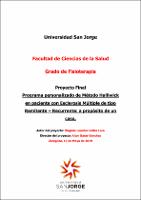Por favor, use este identificador para citar o enlazar este ítem:
https://repositorio.usj.es/handle/123456789/192
Registro completo de metadatos
| Campo DC | Valor | Lengua/Idioma |
|---|---|---|
| dc.contributor.advisor | Garay Sánchez, Aitor | - |
| dc.contributor.author | Vallés Lara, Virginia Lourdes | - |
| dc.date.accessioned | 2019-07-18T08:25:21Z | - |
| dc.date.available | 2019-07-18T08:25:21Z | - |
| dc.date.issued | 2019 | - |
| dc.date.submitted | 2019-06-05 | - |
| dc.identifier.uri | https://repositorio.usj.es/handle/123456789/192 | - |
| dc.description | Introduction and aims. Multiple Sclerosis is a progressive, chronic and disabling disease that is presented with demyelination, inflammation and neurodegenerative tissue damage in the Central Nervous System. The main objective will be to verify the effectiveness of the personalized Halliwick Method Program in a patient with Multiple Sclerosis of the Relapsing-Recurrent type. Also, as secondary objectives to determine changes in the Static and Dynamic balance, muscle power in lower limb, degree of spasticity and quality of life. Methods. A 5-week intervention plan included a 45 minutes workout each session, twice a week. The Static and Dynamic balance has been evaluated with the MiniBest Test and the Dynamic Gait Index. Muscle Power in lower limb has been evaluated with the Five Times Sit to Stand. The degree of spasticity of the knee extensors and ankle plantar flexors with the Ashworth Scale. And the quality of life with the Dizziness Handicap Inventory. These measurements have been made at the beginning and at the end of the intervention. Results. The results show us that there is an improvement in Static and Dynamic balance with a 15/28 (Pre) versus a 25/28 (Post) in MiniBest Test; and 12/24 (Pre) versus 21/24 (Post) in the Dynamic Gait Index. There is also an improvement in muscle power in lower limb with 14.13 sec. (Pre) versus 12,20 sec. (Post). There is also improvement in the degree of spasticity in the knee extensors and ankle plantar flexors with a 2 (Pre) versus 1+ (Post). Finally, there is also an improvement in the quality of life with 58 (Pre) versus 48 (Post). Conclusion. The personalized program of the Halliwick Method is effective for the patient with Multiple Sclerosis of the Remitting-Recurrent type. | es_ES |
| dc.description.abstract | Introducción y objetivos. La Esclerosis Múltiple es una enfermedad progresiva, crónica e incapacitante que cursa con una desmielinización, inflamación y daño tisular neurodegenerativo en el Sistema Nervioso Central. El objetivo principal será comprobar la efectividad del Programa personalizado de Método Halliwick en un paciente con Esclerosis Múltiple de tipo Remitente-Recurrente. Y como objetivos secundarios determinar cambios en equilibrio estático y dinámico, potencia muscular en el miembro inferior, grado de espasticidad y calidad de vida. Materiales y Métodos. El plan de intervención consistió en 5 semanas con 2 sesiones por semana de 45 minutos de duración cada una de ellas. El equilibrio estático y dinámico, se evaluó con MiniBest Test y Dynamic Gait Index. La potencia muscular en el miembro inferior con Five Times Sit to Stand. El grado de espasticidad en los extensores de rodilla y flexores plantares de tobillo con la Escala de Ashworth. Y la calidad de vida con Dizziness Handicap Inventory. Estas mediciones se han realizado al inicio y al final de la intervención. Resultados. Los resultados nos muestran mejoría en el equilibrio estático y dinámico, con un 15/28 (Pre) frente a un 25/28 (Post) en MiniBest Test; y 12/24 (Pre) frente a un 21/24 (Post) en Dynamic Gait Index. Mejoría en la potencia muscular en el miembro inferior con un 14,13 seg. (Pre) frente a un 12,20 (Post). Mejoría en el grado de espasticidad en los extensores de rodilla y flexores plantares de tobillo con un 2 (Pre) frente a 1+( Post). Y mejoría en la calidad de vida con un 58 (Pre) frente a un 48 (Post). Conclusión. El programa personalizado de Método Halliwick es efectivo para esta paciente con Esclerosis Múltiple de tipo Remitente-Recurrente. | es_ES |
| dc.format.extent | 22 p. | es_ES |
| dc.format.mimetype | application/pdf | es_ES |
| dc.language.iso | spa | es_ES |
| dc.language.iso | eng | es_ES |
| dc.relation.requires | Adobe PDF | es_ES |
| dc.rights | Attribution-NonCommercial-NoDerivatives 4.0 Internacional | * |
| dc.rights.uri | http://creativecommons.org/licenses/by-nc-nd/4.0/ | * |
| dc.subject | Esclerosis Múltiple | es_ES |
| dc.subject | Desmielinización | es_ES |
| dc.subject | Hidroterapia | es_ES |
| dc.subject | Sistema Nervioso Central | es_ES |
| dc.subject | Remitente-Recurrente | es_ES |
| dc.title | Programa personalizado de Método Halliwick en paciente con Esclerosis Múltiple de tipo Remitente. Recurrente: a propósito de un caso. | es_ES |
| dc.type | info:eu-repo/semantics/bachelorThesis | es_ES |
| dc.rights.accessrights | info:eu-repo/semantics/openAccess | es_ES |
| Aparece en las colecciones: | Grado en Fisioterapia | |
Ficheros en este ítem:
| Fichero | Descripción | Tamaño | Formato | |
|---|---|---|---|---|
| Programa personalizado de Método Halliwick.pdf | 712,2 kB | Adobe PDF |  Visualizar/Abrir |
Este ítem está sujeto a una licencia Creative Commons Licencia Creative Commons

